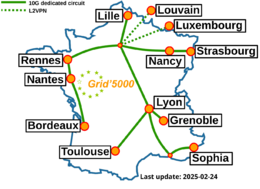Grid5000:Home: Difference between revisions
No edit summary |
Lpouilloux (talk | contribs) No edit summary |
||
| (146 intermediate revisions by 12 users not shown) | |||
| Line 1: | Line 1: | ||
__NOTOC__ __NOEDITSECTION__ | __NOTOC__ __NOEDITSECTION__ | ||
{|width="95%" | {|width="95%" | ||
|- | |- valign="top" | ||
| | |bgcolor="#f5fff5" style="border:1px solid #cccccc;padding:1em;padding-top:0.5em;"| | ||
[[Image: | [[Image:g5k-backbone.png|thumbnail|260px|right|Grid'5000]] | ||
'''Grid'5000 is a large-scale and flexible testbed for experiment-driven research in all areas of computer science, with a focus on parallel and distributed computing including Cloud, HPC and Big Data and AI.''' | |||
'' | Key features: | ||
* provides '''access to a large amount of resources''': 15000 cores, 800 compute-nodes grouped in homogeneous clusters, and featuring various technologies: PMEM, GPU, SSD, NVMe, 10G and 25G Ethernet, Infiniband, Omni-Path | |||
* '''highly reconfigurable and controllable''': researchers can experiment with a fully customized software stack thanks to bare-metal deployment features, and can isolate their experiment at the networking layer | |||
* '''advanced monitoring and measurement features for traces collection of networking and power consumption''', providing a deep understanding of experiments | |||
* '''designed to support Open Science and reproducible research''', with full traceability of infrastructure and software changes on the testbed | |||
* '''a vibrant community''' of 500+ users supported by a solid technical team | |||
<br> | |||
Read more about our [[Team|teams]], our [[Publications|publications]], and the [[Grid5000:UsagePolicy|usage policy]] of the testbed. Then [[Grid5000:Get_an_account|get an account]], and learn how to use the testbed with our [[Getting_Started|Getting Started tutorial]] and the rest of our [[:Category:Portal:User|Users portal]]. | |||
<b>Grid'5000 is merging with [https://fit-equipex.fr FIT] to build the [http://www.silecs.net/ SILECS Infrastructure for Large-scale Experimental Computer Science]. Read [http://www.silecs.net/wp-content/uploads/2018/04/Desprez-SILECS.pdf an Introduction to SILECS] (April 2018)</b> | |||
<br> | |||
Recently published documents and presentations: | |||
* [[Media:Grid5000.pdf|Presentation of Grid'5000]] (April 2019) | |||
* [https://www.grid5000.fr/mediawiki/images/Grid5000_science-advisory-board_report_2018.pdf Report from the Grid'5000 Science Advisory Board (2018)] | |||
Grid'5000 | |||
Older documents: | |||
* [https://www.grid5000.fr/slides/2014-09-24-Cluster2014-KeynoteFD-v2.pdf Slides from Frederic Desprez's keynote at IEEE CLUSTER 2014] | |||
* [https://www.grid5000.fr/ScientificCommittee/SAB%20report%20final%20short.pdf Report from the Grid'5000 Science Advisory Board (2014)] | |||
<br> | |||
Grid'5000 is supported by a scientific interest group (GIS) hosted by Inria and including CNRS, RENATER and several Universities as well as other organizations. Inria has been supporting Grid'5000 through ADT ALADDIN-G5K (2007-2013), ADT LAPLACE (2014-2016), and IPL [[Hemera|HEMERA]] (2010-2014). | |||
|} | |||
--- | |||
<br> | |||
{{#status:0|0|0|http://bugzilla.grid5000.fr/status/upcoming.json}} | |||
<br> | |||
== Random pick of publications == | |||
{{#publications:}} | |||
==Latest news== | |||
<rss max=4 item-max-length="2000">https://www.grid5000.fr/rss/G5KNews.php</rss> | |||
---- | ---- | ||
[[ | [[News|Read more news]] | ||
=== Grid'5000 sites=== | |||
= | {|width="100%" cellspacing="3" | ||
{|width=" | |||
|- valign="top" | |- valign="top" | ||
|width="33%" bgcolor="#f5f5f5" style="border:1px solid #cccccc;padding:1em;padding-top:0.5em;"| | |width="33%" bgcolor="#f5f5f5" style="border:1px solid #cccccc;padding:1em;padding-top:0.5em;"| | ||
* [[Grenoble:Home|Grenoble]] | * [[Grenoble:Home|Grenoble]] | ||
* [[Lille:Home|Lille]] | * [[Lille:Home|Lille]] | ||
* [[Luxembourg:Home|Luxembourg]] | |||
|width="33%" bgcolor="#f5f5f5" style="border:1px solid #cccccc;padding:1em;padding-top:0.5em;"| | |width="33%" bgcolor="#f5f5f5" style="border:1px solid #cccccc;padding:1em;padding-top:0.5em;"| | ||
* [[Lyon:Home|Lyon]] | * [[Lyon:Home|Lyon]] | ||
* [[Nancy:Home|Nancy]] | * [[Nancy:Home|Nancy]] | ||
* [[ | * [[Nantes:Home|Nantes]] | ||
|width="33%" bgcolor="#f5f5f5" style="border:1px solid #cccccc;padding:1em;padding-top:0.5em;"| | |width="33%" bgcolor="#f5f5f5" style="border:1px solid #cccccc;padding:1em;padding-top:0.5em;"| | ||
* [[Rennes:Home|Rennes]] | * [[Rennes:Home|Rennes]] | ||
| Line 91: | Line 60: | ||
|- | |- | ||
|} | |} | ||
== Current funding == | == Current funding == | ||
As from June 2008, | As from June 2008, Inria is the main contributor to [[Grid5000:Funding|Grid'5000 funding]]. | ||
{|width="100%" cellspacing="3" | {|width="100%" cellspacing="3" | ||
|- | |- | ||
| width="50%" bgcolor="#f5f5f5" valign="top" align="center" style="border:1px solid #cccccc;padding:1em;padding-top:0.5em;"| | | width="50%" bgcolor="#f5f5f5" valign="top" align="center" style="border:1px solid #cccccc;padding:1em;padding-top:0.5em;"| | ||
===INRIA=== | ===INRIA=== | ||
[[Image: | [[Image:Logo_INRIA.gif|300px]] | ||
| width="50%" bgcolor="#f5f5f5" valign="top" align="center" style="border:1px solid #cccccc;padding:1em;padding-top:0.5em;"| | | width="50%" bgcolor="#f5f5f5" valign="top" align="center" style="border:1px solid #cccccc;padding:1em;padding-top:0.5em;"| | ||
===CNRS=== | ===CNRS=== | ||
[[Image: | [[Image:CNRS-filaire-Quadri.png|125px]] | ||
|- | |- | ||
| width="50%" bgcolor="#f5f5f5" valign="top" align="center" style="border:1px solid #cccccc;padding:1em;padding-top:0.5em;"| | | width="50%" bgcolor="#f5f5f5" valign="top" align="center" style="border:1px solid #cccccc;padding:1em;padding-top:0.5em;"| | ||
===Universities=== | ===Universities=== | ||
IMT Atlantique<br/> | |||
Université Grenoble Alpes, Grenoble INP<br/> | |||
Université Rennes 1, Rennes<br/> | |||
Institut National Polytechnique de Toulouse / INSA / FERIA / Université Paul Sabatier, Toulouse<br/> | Institut National Polytechnique de Toulouse / INSA / FERIA / Université Paul Sabatier, Toulouse<br/> | ||
Université Bordeaux 1, Bordeaux<br/> | |||
Université Lille 1, Lille<br/> | |||
École Normale Supérieure, Lyon<br/> | |||
| width="50%" bgcolor="#f5f5f5" valign="top" align="center" style="border:1px solid #cccccc;padding:1em;padding-top:0.5em;"| | | width="50%" bgcolor="#f5f5f5" valign="top" align="center" style="border:1px solid #cccccc;padding:1em;padding-top:0.5em;"| | ||
===Regional councils=== | ===Regional councils=== | ||
Aquitaine<br/> | |||
Auvergne-Rhône-Alpes<br/> | |||
Bretagne<br/> | Bretagne<br/> | ||
Champagne-Ardenne<br/> | |||
Provence Alpes Côte d'Azur<br/> | Provence Alpes Côte d'Azur<br/> | ||
Hauts de France<br/> | |||
Lorraine<br/> | Lorraine<br/> | ||
|} | |} | ||
Latest revision as of 10:29, 26 October 2023
|
Grid'5000 is a large-scale and flexible testbed for experiment-driven research in all areas of computer science, with a focus on parallel and distributed computing including Cloud, HPC and Big Data and AI. Key features:
Grid'5000 is merging with FIT to build the SILECS Infrastructure for Large-scale Experimental Computer Science. Read an Introduction to SILECS (April 2018)
Older documents:
|
Random pick of publications
Five random publications that benefited from Grid'5000 (at least 2517 overall):
- Ilhem Fajjari, Wassim Aroui, Joaquim Soares, Vania Marangozova. Use Cases Requirements. UGA (Université Grenoble Alpes). 2024. hal-04450028 view on HAL pdf
- Ronan-Alexandre Cherrueau, Marie Delavergne, Alexandre van Kempen, Adrien Lebre, Dimitri Pertin, et al.. EnosLib: A Library for Experiment-Driven Research in Distributed Computing. IEEE Transactions on Parallel and Distributed Systems, 2022, 33 (6), pp.1464-1477. 10.1109/TPDS.2021.3111159. hal-03324177 view on HAL pdf
- Maxime Lanvin, Pierre-François Gimenez, Yufei Han, Frédéric Majorczyk, Ludovic Mé, et al.. Towards understanding alerts raised by unsupervised network intrusion detection systems. The 26th International Symposium on Research in Attacks, Intrusions and Defenses (RAID ), Oct 2023, Hong Kong China, France. pp.135-150, 10.1145/3607199.3607247. hal-04172470 view on HAL pdf
- Shakeel Sheikh, Md Sahidullah, Fabrice Hirsch, Slim Ouni. Robust Stuttering Detection via Multi-task and Adversarial Learning. EUSIPCO 2022 - 30th European Signal Processing Conference, Aug 2022, Belgrade, Serbia. hal-03629785 view on HAL pdf
- Ashwin Geet d'Sa. Expanding the training data for neural network based hate speech classification. Computer Science cs. Université de Lorraine, 2022. English. NNT : 2022LORR0081. tel-03833821 view on HAL pdf
Latest news
![]() Cluster "estats" is now in the default queue in Toulouse
Cluster "estats" is now in the default queue in Toulouse
We are pleased to announce that the estats cluster of Toulouse (the name refers to Pica d'Estats) is now available in the default queue.
As a reminder, estats is composed of 12 edge-class nodes powered by Nvidia AGX Xavier SoCs. Each node features:
Since it is not a cluster of server-class machines (unlike all current other Grid'5000 nodes), estats runs a different default system environment, but other common functionalities are the same (kadeploy etc., except kavlan which is not supported yet).
For the experimentations, it is recommended to deploy Ubuntu L4T.
More information in the Jetson page.
The cluster was funded by a CNRS grant.
-- Grid'5000 Team 9:51, March 6th 2024 (CEST)
![]() The big variant of Debian 12 "Bookworm" environments is ready for deployments
The big variant of Debian 12 "Bookworm" environments is ready for deployments
We are pleased to inform you that the big variant of Debian 12 (Bookworm) environments is now supported for deployments in Grid'5000. Check `kaenv3 -l debian12%` for detailed information.
Notably, the NVIDIA driver has been updated to version 535.129.03, and CUDA has been upgraded to version 12.2.2_535.104.05_linux for the amd64 architecture.
The default environment available on nodes will continue to be debian11-std for the foreseeable future.
Please refer to the updated wiki documentation¹ for guidance on Debian 12-min|nfs|big usage.
¹: https://www.grid5000.fr/w/Getting_Started#On_Grid.275000_reference_environments
-- Grid'5000 Team 14:21, Jan 22nd 2024 (CEST)
![]() Cluster "montcalm" is now in the default queue in Toulouse
Cluster "montcalm" is now in the default queue in Toulouse
We have the pleasure to announce that the "montaclm" cluster is now available in the default queue of the Toulouse site, which makes the site full-fledged again!
This cluster consists of 10 HPE Proliant DL360 Gen10+ nodes with 2 CPUs Intel Xeon Silver 4314 (16 cores per CPUs), 256 GB of DDR4 RAM, and 894GB SSD.
Jobs submitted on the Toulouse site will run by default on this cluster.
Beside the "montcalm" cluster, the "edge-class" cluster "estats" is still available in the testing queue for now.
In order to support the SLICES-FR project, the site infrastructure has been funded by CNRS/INS2I and the "montcalm" cluster has been funded by University Paul Sabatier (UT3).
-- Grid'5000 Team 10:30, 18 Jan 2024 (CET)
![]() New "edge-computing"-class nodes in Toulouse's testing queue: cluster Estats with 12 Nvidia AGX Xavier SoCs
New "edge-computing"-class nodes in Toulouse's testing queue: cluster Estats with 12 Nvidia AGX Xavier SoCs
A new cluster named "estats" is available in the testing queue of the Toulouse site, composed of 12 "Edge computing"-class nodes.
Estats is composed of 12 Nvidia AGX Xavier SoCs¹. Each SoC features:
The 12 modules are packaged in a chassis manufactured by Connecttech⁴.
Since it is not a cluster of server-class machines (unlike all current other Grid'5000 nodes), estats runs a different default system environment. This environment includes Nvidia's Linux for Tegra²³ overlay on top of the Grid'5000 standard environment. This means:
This default environment does not include the required Tegra-specific version of Cuda.
To benefit from the whole Nvidia stack with e.g. the specific Cuda version and DL accelerators support for Nvidia Tegra, it is advised to deploy on the node the Nvidia-supported Ubuntu 20.04 OS with the full L4T support, using kadeploy. You can use the ubuntul4t200435-big environment. E.g.:
ftoulouse$ oarsub -q testing -t exotic -p estats -t deploy -l nodes=1 -I
ftoulouse$ kadeploy3 ubuntul4t200435-big
This tutorial page explains how this ubuntul4t200435-big environment is built and how to...
Grid'5000 sites
Current funding
As from June 2008, Inria is the main contributor to Grid'5000 funding.
INRIA |
CNRS |
UniversitiesIMT Atlantique |
Regional councilsAquitaine |


